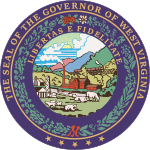Henry D. Hatfield
| Henry D. Hatfield | |
|---|---|
 | |
| United States Senator from West Virginia | |
|
In office March 4, 1929 – January 3, 1935 | |
| Preceded by | Matthew M. Neely |
| Succeeded by | Rush D. Holt Sr. |
| 14th Governor of West Virginia | |
|
In office March 14, 1913 – March 5, 1917 | |
| Preceded by | William E. Glasscock |
| Succeeded by | John J. Cornwell |
| President of the West Virginia Senate | |
|
In office 1911–1913 | |
| Governor | William E. Glasscock |
| Preceded by | L. J. Forman |
| Succeeded by | Samuel V. Woods |
| Member of the West Virginia Senate | |
|
In office 1908-1912 | |
| Personal details | |
| Born |
September 15, 1875 Mingo County, West Virginia |
| Died |
October 23, 1962 (aged 87) Huntington, West Virginia |
| Political party | Republican |
| Spouse(s) | South Carolina "Carrie" Bronson Hatfield |
| Profession | Politician |
| Religion | Methodism |
Henry Drury Hatfield (September 15, 1875 – October 23, 1962) was a Republican politician from Logan County, West Virginia. He served a term as the 14th Governor of the state, in addition to one term in the United States Senate. Hatfield was nephew to Devil Anse Hatfield, leader of the Hatfield clan.
Hatfield was born in Logan County (present-day Mingo County, West Virginia) on September 15, 1875. He graduated from Franklin College in New Athens, Ohio. He later obtained medical degrees from what is now known as the University of Louisville and later from New York University. In 1895, he married South Carolina "Carrie" Bronson.[1]
He was appointed as surgeon for the Norfolk and Western Railway (1895–1913) and surgeon in chief of State Hospital #1 in Welch, West Virginia (1899–1913). He entered local politics first as commissioner of district roads of McDowell County (1900–1905), eventually becoming member of the State senate (1908–1912), and serving as president of the senate in 1911.
He was elected as Governor of West Virginia in 1912. He began his term by court-martialing forty-nine Socialist leaders, including Mother Jones, and then moving to negotiate a compromise to end the deadly Paint Creek–Cabin Creek strike. The settlement presented to coal operators by Hatfield and the UMWA was staunchly opposed by local Socialists. In response, Hatfield deployed soldiers to force miners to agree to the compromise and ordered presses at Socialist newspapers in Huntington and Charleston destroyed.[2] Following the expiration of his term in 1917, he entered the United States Army as a Major in the Medical Corps, serving as chief of the Surgical Service at Base Hospital No. 36 in Detroit, Michigan.
He was discharged in 1919 and returned to West Virginia. In 1928, he was elected to the United States Senate as a Republican, and served from March 4, 1929 to January 3, 1935. He was defeated in a bid for reelection in 1934.
After leaving the Senate, Hatfield settled in Huntington, West Virginia and established a private medical practice, where he worked until his death in 1962.
References
External links
- United States Congress. "Henry D. Hatfield (id: H000342)". Biographical Directory of the United States Congress.
- Biography of Henry D. Hatfield
- Inaugural Address of Henry D. Hatfield
| Political offices | ||
|---|---|---|
| Preceded by L. J. Forman |
President of the West Virginia Senate 1911–1913 |
Succeeded by Samuel V. Woods |
| Preceded by William E. Glasscock |
Governor of West Virginia 1913–1917 |
Succeeded by John J. Cornwell |
| United States Senate | ||
| Preceded by Matthew M. Neely |
Class 1 U.S. Senator from West Virginia 1929–1935 |
Succeeded by Rush D. Holt Sr. |


